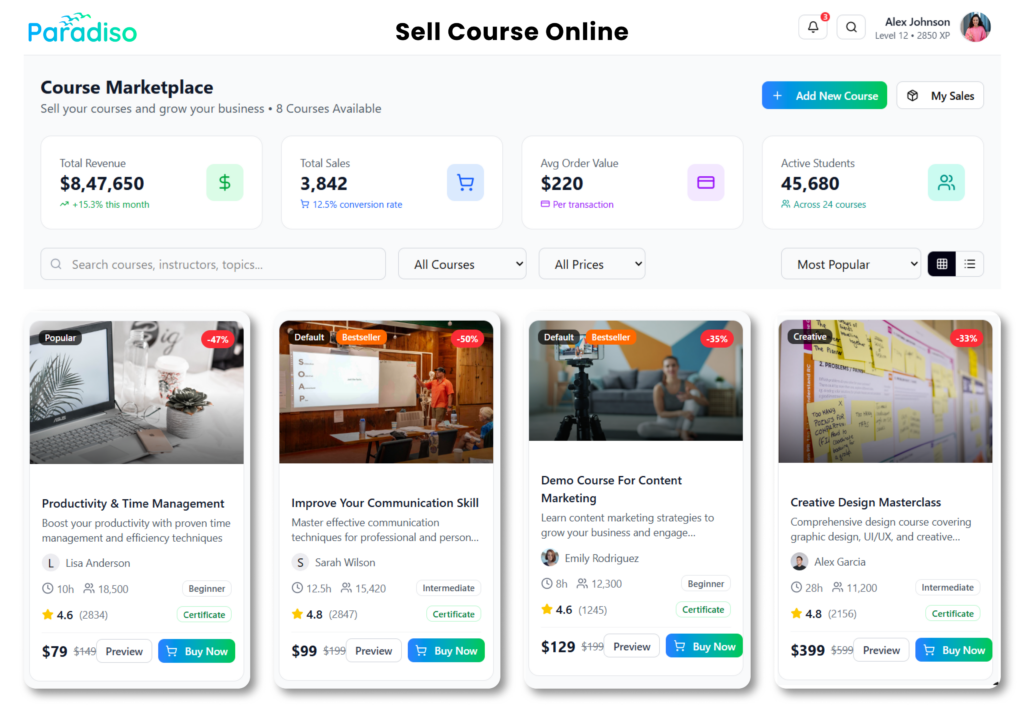In today’s rapidly changing business landscape, fostering continuous learning and professional development is essential for organizations to stay competitive. A Learning Management System (LMS) offers a powerful solution to streamline training programs and empower employees with convenient access to valuable resources. Setting up an LMS within your organization requires careful planning and execution. In this guide, we will delve into the fundamental steps to establish an effective LMS tailored to your specific needs. Join us on this professional journey to unlock the potential of a robust learning infrastructure that will elevate your organization’s growth and success.
What is a Learning Management System?
A Learning Management System (LMS) is like a digital headquarters for training and education within an organization. It’s a platform that brings everything together in one place, making it easier for administrators to create and manage courses, distribute learning materials, and keep track of learners’ progress. With an LMS, you can do effective things like create quizzes and discussions, share videos and other interactive content, and generate reports to see how everyone is doing. It’s a powerful tool that helps organizations deliver engaging learning experiences, keep everyone on the same page, and promote continuous growth and development.
Who can use an LMS?
LMS is utilized by a wide range of individuals and organizations seeking to enhance their learning and training initiatives. It is commonly employed by educational institutions, from K-12 schools to universities, enabling teachers and students to manage course materials, assignments, and assessments. In the corporate world, businesses of all sizes and industries rely on LMS platforms to deliver employee training programs, onboarding processes, and compliance training. Additionally, professional training organizations, government agencies, and non-profit organizations also make use of LMS to provide specialized courses and certifications. In essence, LMS serves as a versatile tool catering to the learning needs of students, employees, and lifelong learners across various sectors.
Contact us today to discuss your project
The 15 Must-Have Features of a Learning Management System
Below mentioned features are essential for providing effective online learning experiences and managing training programs. Here are the 15 must-have LMS features:
User Management:
The LMS should have robust user management capabilities, allowing administrators to create and manage user accounts, assign roles, and track user progress.
Built-in Course Authoring Tool:
The LMS should have a built-in course authoring tool that allows instructors or subject matter experts to create and develop interactive and engaging online courses without the need for additional authoring software.
Content Management:
It should have a content management system that enables administrators to upload, organize, and deliver various types of content, such as documents, videos, and multimedia files.
Assessment and Grading:
The LMS should support creating and administering assessments, quizzes, and assignments. It should also provide automated grading and feedback mechanisms.
Reporting and Analytics:
It should offer robust reporting and analytics features, allowing administrators to track learner progress, generate reports, and gain insights into the effectiveness of courses and training programs.
Mobile Compatibility:
The LMS should be mobile-friendly and responsive, enabling learners to access content and participate in courses from various devices, including smartphones and tablets.
Gamification:
Gamification features, such as badges, leaderboards, and rewards, can enhance learner engagement and motivation. The LMS should support gamification elements to make the learning experience more enjoyable.
Social Learning:
The LMS should facilitate social learning through features like discussion forums, chat rooms, and collaborative activities, promoting interaction and knowledge sharing among learners.
Communication Tools:
It should have built-in communication tools, such as messaging systems or notifications, to enable seamless communication between learners, instructors, and administrators.
Personalization and Customization:
The LMS should allow administrators to customize the user interface, branding, and course delivery to align with the organization’s unique requirements and branding guidelines.
Integration Capabilities:
It should have the ability to integrate with other systems, such as HR software, content authoring tools, or video conferencing platforms, to streamline workflows and provide a unified learning experience.
Compliance and Certification Management:
The LMS should support compliance training by enabling administrators to track certifications, manage regulatory requirements, and generate compliance reports.
Accessibility:
It should adhere to accessibility standards, ensuring that learners with disabilities can access and navigate the content easily.
Multilingual Support:
The LMS should support multiple languages, allowing learners from different regions or with different language preferences to access the platform and course content in their preferred language.
Scalability and Reliability:
The LMS should be scalable and capable of handling a growing number of learners and courses while also maintaining high availability and performance.
Why does your organization need an LMS?
Centralized Learning Hub:
An LMS provides a centralized platform where all learning resources, courses, and training materials can be stored, organized, and accessed by employees or learners. This eliminates the hassle of managing multiple systems or relying on fragmented sources of information.Streamlined Training Management:
With an LMS, you can efficiently manage and streamline training programs. Administrators can easily create and update courses, track learner progress, schedule training sessions, and automate reminders and notifications. This saves time and resources compared to manual training management processes.Flexible and Convenient Learning:
An LMS offers flexibility in terms of when and where employees can access training materials. They can learn at their own pace, fitting training into their schedules without disrupting daily operations. This convenience increases engagement and knowledge retention.Enhanced Employee Development:
An LMS facilitates continuous professional development by offering a range of learning resources, including online courses, webinars, and interactive content. It allows employees to acquire new skills, stay updated with industry trends, and improve job performance, leading to career growth and increased job satisfaction.Consistent and Standardized Training:
An LMS ensures that all employees receive consistent training materials and standardized information across the organization. This promotes a cohesive learning experience and helps maintain compliance with regulations and industry standards.Performance Tracking and Analytics:
LMS platforms provide comprehensive tracking and reporting features that allow administrators to monitor learners’ progress, identify knowledge gaps, and assess the effectiveness of training programs. This data-driven approach helps make informed decisions for optimizing training initiatives and improving overall performance.Cost and Time Efficiency:
Implementing an LMS can save costs associated with traditional classroom training, such as travel expenses, venue rentals, and printed materials. Moreover, it reduces the time required for training coordination and administration, enabling employees to focus on their core responsibilities.Scalability and Growth:
An LMS can easily accommodate evolving training needs as organizations expand or undergo changes. New courses or modules can be added, and the system can handle many users, making it a scalable solution for long-term growth.Which is Better Readymade or Custom LMS?
The choice between a readymade or custom Learning Management System (LMS) depends on the specific needs and resources of the organization. In most cases, a readymade LMS is the ideal choice. It offers a pre-built platform with many features, quick implementation, and lower upfront costs.
Readymade LMS solutions often have regular updates, technical support, and a user-friendly interface. They are suitable for organizations that require standard functionalities and have limited time and budget for customization.
On the other hand, a custom LMS is recommended for organizations with unique or complex requirements that off-the-shelf solutions cannot fully meet. Customization allows for tailored features, integrations, and branding, providing a more personalized and seamless user experience. However, it involves higher costs, longer development time, and ongoing maintenance. Ultimately, the decision should be based on the organization’s specific needs, budget, and timeline for implementation.
How to develop LMS platform for your enterprise?
Research and Select the Platform:
Conduct thorough research on LMS platforms available in the market, including Paradiso enterprise LMS. Evaluate their features, pricing, scalability, and customer reviews. Choose the platform that best aligns with your organization’s requirements and budget.
Platform Implementation:
Once you have selected the LMS platform, begin the implementation process. This involves setting up the platform, configuring the settings, and integrating it with other systems if necessary. Ensure the platform is customized to reflect your organization’s branding and tailored to your training needs.
Staff Training:
Provide comprehensive training to staff members who will be using the LMS. Conduct training sessions, workshops, or online tutorials to familiarize them with the platform’s features, functionalities, and workflows. Offer hands-on practice and guidance to ensure they feel comfortable navigating and utilizing the LMS effectively.
Continuous Support:
Establish a support system to assist staff members with any questions, issues, or technical difficulties they may encounter while using the LMS. Provide ongoing support through channels such as email, chat, or a dedicated helpdesk. Regularly communicate updates, tips, and best practices to enhance staff engagement and adoption of the LMS.
Collecting Feedback:
Implement a feedback mechanism to gather input from staff members on their experience with the LMS. This can be done through surveys, focus groups, or one-on-one feedback sessions. Encourage open and honest feedback regarding the LMS platform’s usability, functionality, and overall satisfaction.
Analyze and Act on Feedback:
Analyze the collected feedback and identify common themes, suggestions, or concerns. Use this feedback to make necessary improvements and optimizations to the LMS platform. Address any issues or challenges raised by staff members promptly and transparently.
Continuous Improvement:
As you gather feedback and improve, ensure a continuous improvement cycle. Regularly assess the effectiveness of the LMS platform, evaluate user satisfaction, and implement enhancements based on evolving needs and emerging technologies.
What is White Label LMS? And why should you consider it?
White Label LMS refers to a learning management system that can be customized and rebranded with an organization’s branding and logo. By choosing a white-label LMS, you can create a seamless learning experience that aligns with your brand identity, enhances credibility, and fosters a sense of ownership. It allows you to present a cohesive and consistent training platform to your learners while maintaining full control over the user experience and a professional image.
Final thoughts
Choosing the right LMS from numerous options might feel confusing, but it can bring great rewards once you find the perfect fit. LMS platforms personalize learning experiences and help businesses expand globally.
With careful research, you can discover the ideal LMS for your organization, allowing you to capitalize on its benefits. Paradiso LMS, a white-label solution, enables organizations to create a customized and branded learning environment that enhances their brand identity and professionalism.














